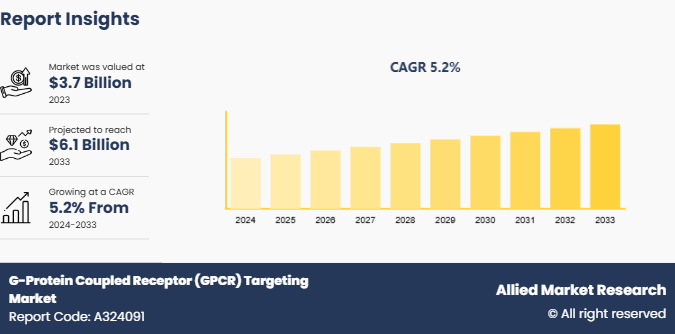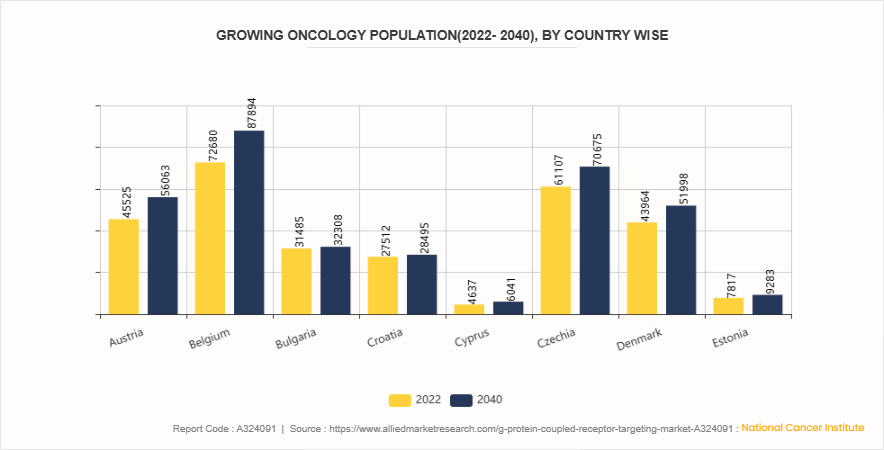The global g-protein coupled receptor (GPCR) targeting market size was valued at $3.7 billion in 2023, and is projected to reach $6.1 billion by 2033, growing at a CAGR of 5.2% from 2024 to 2033. Rise in precalance of chronic diseases is driving the demand for GPCR technology and thereby driving the market growth.

Market Introduction and Definition
G Protein-Coupled Receptor (GPCR) targeting refers to the development of therapeutic drugs that specifically interact with GPCRs, a large family of cell surface receptors involved in various physiological processes. GPCRs play a crucial role in transmitting signals from the external environment to the inside of cells, influencing functions such as vision, taste, and hormone responses. Due to their central role in disease pathways, GPCRs are a primary focus in drug discovery. Targeting GPCRs allows for precise modulation of cellular responses, making it an essential approach in treating conditions such as cardiovascular diseases, cancer, and neurological disorders.
Key Takeaways
- The G-protein coupled receptor (GPCR) targeting market share study covers 20 countries. The research includes a segment analysis of each country in terms of value ($Billion) for the projected G-protein coupled receptor (GPCR) targeting market forecast period 2024-2033.
- More than 1, 500 product literatures, industry releases, annual reports, and other such documents of major G-protein coupled receptor (GPCR) targeting industry participants along with authentic industry journals, trade associations' releases, and government websites have been reviewed for generating high-value industry insights.
- The study integrated high-quality data, professional opinions and analysis, and critical independent perspectives. The research approach is intended to provide a balanced view of global markets and to assist stakeholders in making educated decisions in order to achieve their most ambitious growth objectives.
Key Market Dynamics
One of the major drivers for the GPCR targeting market is the increasing prevalence of chronic diseases. GPCRs are involved in numerous physiological processes, including cardiovascular regulation, immune responses, and sensory perception, making them critical targets for many chronic conditions such as diabetes, cancer, and cardiovascular diseases. As the global population ages and the incidence of these conditions rises, there is a growing demand for effective therapies that leverage GPCRs. This has led to a surge in drug discovery and development efforts aimed at GPCRs, positioning the market for robust growth. In addition, advancements in biotechnology and structural biology have improved the understanding of GPCRs, enabling the creation of more precise and efficient drugs, further driving the market.
However, the factor that restraint the G-protein coupled receptor (GPCR) targeting market growth is the complexity associated with GPCR drug development. GPCRs are structurally complex and are involved in a wide array of signaling pathways, which can make targeting them with drugs challenging. Developing GPCR-targeted therapies often requires sophisticated technologies and significant research and development investments, which can extend drug development timelines and increase costs. Furthermore, many GPCRs are not fully understood, which adds an additional layer of difficulty to designing drugs that are both effective and safe. This complexity can deter smaller biotech firms from entering the market and slow overall progress.
On the other hand, a significant opportunity lies in the rising focus on precision medicine. As personalized therapies become more central to healthcare, the ability to design GPCR-targeted drugs that cater to individual genetic profiles presents a major growth avenue. Advances in genetic profiling and biomarker research allow for the development of GPCR therapies that are highly specific to individual patients, leading to more effective treatments with fewer side effects. This trend is expected to create opportunities for pharmaceutical companies to develop niche therapies for smaller patient populations, further expanding the GPCR targeting market.
Growing Oncology Population (2022-2040) , by country wise
The growing oncology population across various countries presents a significant opportunity for the G protein-coupled receptor (GPCR) targeting market, as GPCRs play a critical role in cancer drug development. For instance, by 2040, Austria's cancer cases are expected to rise from 45, 525 in 2022 to 56, 063, while Belgium will see an increase from 72, 680 to 87, 894. Similar growth trends are observed in Czechia, Denmark, and other countries, thus driving demand for innovative cancer therapies. This rise in cancer incidence emphasizes the need for advanced, targeted treatments, such as GPCR-targeting drugs, to address the expanding oncology population and improve therapeutic outcomes.

Market Segmentation
The G-protein coupled receptor (GPCR) targeting industry is segmented into product type, assay type, application, and region. On the basis of product type, the market is categorized into Cell Lines, Detection Kits, Cell Culture Reagents, and Ligand. On the basis of assay type, the market is segmented into Calcium Level Detection Assays, Radioligand Binding and GTPγS Functional Assays, cAMP Assays and cGMP Assays, β-Arrestin Functional Assays, Reporter Gene Assays, and Other Assay Types. On the basis of application, the market is segmented into Cardiovascular System, Central Nervous System (CNS) , Oncology, and Other Applications. Region wise, it is analyzed across North America, Europe, Asia-Pacific, and LAMEA.
Regional/Country Market Outlook
The G-protein coupled receptor (GPCR) targeting market size shows varied growth potential across different regions. North America dominates the market due to a robust pharmaceutical industry, high R&D investment, and increasing prevalence of chronic diseases such as cancer and diabetes. Europe follows closely, driven by significant government funding in biomedical research and a strong presence of biotechnology firms. Asia-Pacific, particularly countries such as China and India, is expected to witness the fastest growth owing to a large patient pool, rise in healthcare expenditure, and increase in focus on innovative drug discovery. Latin America and Middle East & Africa are growing steadily, with improvements in healthcare infrastructure and access to advanced therapies.
Industry Trends
- An article published by Elsevier Inc., from 2014 to 2023, the FDA approved 104 GPCR-targeting drugs over the past decade. This trend highlights the growing importance of these receptors in therapeutic applications, particularly in managing chronic diseases like obesity and diabetes.
- An article published by American Society for Pharmacology and Experimental Therapeutics in 2021 stated the exploration of genetic mutations in GPCR genes revealed links to various inherited diseases. There are approximately 800 annotated G protein–coupled receptor (GPCR) genes, making these membrane receptors members of the most abundant gene family in the human genome. The identification of nearly 800 GPCR genes in the human genome emphasizes their significance as drug targets for a wide range of diseases. This growing understanding accelerates research and development of GPCR-targeted therapies, fueling G-protein coupled receptor (GPCR) targeting market growth.
Competitive Landscape
The major players operating in the G-protein coupled receptor (GPCR) targeting market share include Abcam plc, Becton, Dickinson and Company, PerkinElmer Inc., Merck KGaA, Enzo Biochem Inc. (Enzo Life Sciences Inc.) , Danaher (Molecular Devices LLC) , Promega Corporation, BioInvenu Inc., Thermo Fisher Scientific, Eurofins Scientific, Addex Therapeutics, and HD Biosciences Co., Ltd.
Recent Key Strategies and Developments
- In April 2022, Ono Pharmaceutical Co., Ltd., announced that it has newly signed a collaboration agreement with Domain Therapeutics S.A. and Université de Montréal, to discover novel small molecules targeting G-Protein Coupled Receptors (GPCRs) in a metabolic disease area. Under the agreement, Ono will collaborate with Domain and UdM utilizing the bioSens-All technology GPCR drug discovery platform.
- In January 2022, Septerna, Inc., a biotechnology company discovering and advancing novel small molecule medicines targeting G protein-coupled receptors (GPCRs) , announced its launch and Series A financing of $100 million. The Series A financing will enable Septerna to advance its emerging pipeline of novel GPCR-targeted drug programs, enabled by the Native ComplexTM Platform and spanning multiple therapeutic areas.
Key Sources Referred
- International Union of Basic and Clinical Pharmacology (IUPHAR)
- Centers for Medicare & Medicaid Services (CMS)
- Medical Research Council (MRC) - UK
- Medicines and Healthcare Products Regulatory Agency (MHRA)
- Thermo Fisher Scientific website
- European Medicines Agency (EMA)
- National Institutes of Health (NIH)
- National Center for Biotechnology Information (NCBI)
- Canadian Institutes of Health Research (CIHR)
- European Federation of Pharmaceutical Industries and Associations (EFPIA)
Key Benefits for Stakeholders
- This report provides a quantitative analysis of the G-protein coupled receptor (GPCR) targeting market segments, current trends, estimations, and dynamics of the G-protein coupled receptor (GPCR) targeting market analysis from 2023 to 2033 to identify the prevailing market opportunities.
- The market research is offered along with information related to key drivers, restraints, and opportunities.
- Porter's five forces analysis highlights the potency of buyers and suppliers to enable stakeholders make profit-oriented business decisions and strengthen their supplier-buyer network.
- In-depth analysis of the G-protein coupled receptor (GPCR) targeting market segmentation assists to determine the prevailing G-protein coupled receptor (GPCR) targeting market opportunity.
- Major countries in each region are mapped according to their revenue contribution to the global G-protein coupled receptor (GPCR) targeting market statistics.
- Market player positioning facilitates benchmarking and provides a clear understanding of the present position of the market players.
- The report includes the analysis of the regional as well as global G-protein coupled receptor (GPCR) targeting market trends, key players, market segments, product type areas, and market growth strategies.
G-Protein Coupled Receptor Report Highlights
| Aspects | Details |
| Market Size By 2033 | USD 6.1 Billion |
| Growth Rate | CAGR of 5.2% |
| Forecast period | 2024 - 2033 |
| Report Pages | 216 |
| By Product Type |
|
| By Assay Type |
|
| By Application |
|
| By Region |
|
| Key Market Players | Thermo Fisher Scientific Inc., Wuxi AppTec Co., Ltd., Merck KGaA, Promega Corporation, Eurofins Scientific SE, Qiagen NV., PerkinElmer Inc., BioInvenu Inc, Abcam plc, Enzo Biochem Inc. |
The total market value of G-Protein Coupled Receptor (GPCR) Targeting Market was $ 3.7 billion in 2023.
The market value of G-Protein Coupled Receptor (GPCR) Targeting Market is projected to reach $ 6.1 billion by 2033.
The forecast period for G-Protein Coupled Receptor (GPCR) Targeting Market is 2024 to 2033
The base year is 2023 in G-Protein Coupled Receptor (GPCR) Targeting Market.
G Protein-Coupled Receptor (GPCR) targeting refers to the development of therapeutic drugs that specifically interact with GPCRs, a large family of cell surface receptors involved in various physiological processes.
Loading Table Of Content...



